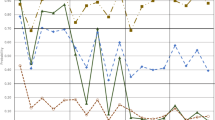Abstract
Previous research has rarely distinguished among the effects of minimal, moderate, and severe physical punishment on children's antisocial aggression. Using a nationally representative sample, this study compared the effects of different frequencies of physical punishment on children's reported physical aggression against other family members. In addition, the interaction of parental reasoning with physical punishment was examined. All analyses were repeated for preschoolers, preadolescents, and adolescents. The results generally indicated a linear positive association between physical punishment and child aggression. For preadolescent and adolescent aggression toward the parent, however, this association depended upon parental use of reasoning, such that spanking had a minimal effect on aggression for frequent reasoners. The combination of infrequent reasoning and frequent spanking was associated with dramatically increased aggression. The conclusion emphasizes additional unresolved issues about the effects of spanking, particularly the ambiguous direction of causal influence between parent and child.
Similar content being viewed by others
References
Baumrind, D. (1973). The development of instrumental competence through socialization. In Pick, A. D. (ed.),Minnesota Symposia on Child Psychology, Vol. 7, University of Minnesota Press, Minneapolis, pp. 3–46.
Bryan, J. W., and Freed, F. W. (1982). Corporal punishment: Normative data and sociological and psychological correlates in a community college population.J. Youth Adolescence 11: 77–87.
Cook, T. D., and Campbell, D. T. (1979).Quasi-experimentation, Rand McNally, Chicago.
Gelles, R. J. (1972).The Violent Home: A Study of Physical Aggression between Husbands and Wives, Sage, Beverly Hills, Calif.
George, C., and Main, M. (1979). Social interactions of young abused children: Approach, avoidance and aggression.Child Devel. 50: 306–318.
Gil, D. G. (1971). Violence against children.J. Marriage Family 33: 644–648.
Johannesson, I. (1974). Aggressive behavior among school children related to maternal practices in early childhood. In de Witt, J., and Hartup, W. W. (eds.),Determinants and Origins of Aggressive Behavior, Mouton, The Hague.
Lefkowitz, M. M., Eron, L. D., Walder, L. O., and Huesmann, L. R. (1977).Growing Up To Be Violent, Pergamon Press, New York.
Oates, R. K., Davis, A. A., and Ryan, M. G. (1980). Predictive factors for abuse.Aust. Paed. J. 16: 239–243.
Palmer, S. (1960).The Psychology of Murder, Thomas Y. Crowell, New York.
Parke, R. D., and Collmer, C. W. (1975). Child abuse: An interdisciplinary analysis. In Hetherington, E. M. (ed.),Review of Child Development Research, Vol. 5, University of Chicago Press, Chicago.
Parke, R. D., and Slaby, R. G. (1983). The development of aggression. In Mussen, P. H. (ed.),Handbook of Child Psychology: Vol. 4, Socialization, Personality, and Social Development, Wiley, New York, pp. 547–641.
Reid, J. R., Patterson, G. R., and Loeber, R. (1982). The abused child: Victim, instigator, or innocent bystander. In Berstein, J. (ed.),Response Structure and Organization, University of Nebraska Press, Lincoln.
Sears, R. R. (1961). Relation of early socialization experiences to aggression in middle childhood.J. Abnorm. Social Psychol. 63: 466–492.
Sears, R. R., Maccoby, E. E., and Levin, H. (1957).Patterns of Child-rearing, Harper and Row, New York.
Straus, M. A. (1979). Measuring intrafamily conflict and violence: The Conflict Tactics (CT) Scales.J. Marriage Family 41: 75–88.
Straus, M. A. (1983). Ordinary violence, child abuse, and wife-beating. In Finkelhor, D., Gelles, R. J., Hotaling, G. T., and Straus, M. A. (eds.),The Dark Side of Families: Current Family Violence Research, Sage, Beverly Hills, Calif., pp. 213–234.
Straus, M. A., Gelles, R. J., and Steinmetz, S. K. (1980).Behind Closed Doors: Violence in the American Family, Anchor Books, Garden City, N.Y.
Trickett, P., and Kuczynski, L. (1983, August).Children's Misbehaviors and Parental Discipline in Abusive and Non-abusive Families, Paper presented at the meeting of the American Psychological Association, Anaheim, Calif.
Watson, G. (1957). Some personality differences in children related to strict or permissive parental discipline.J. Psychol. 44: 227–249.
Welsh, R. S. (1976). Severe parental punishment and delinquency: A developmental theory.J. Clin. Child Psychol. 5: 17–21.
Author information
Authors and Affiliations
Rights and permissions
About this article
Cite this article
Larzelere, R.E. Moderate spanking: Model or deterrent of children's aggression in the family?. J Fam Viol 1, 27–36 (1986). https://doi.org/10.1007/BF00977030
Received:
Issue Date:
DOI: https://doi.org/10.1007/BF00977030



